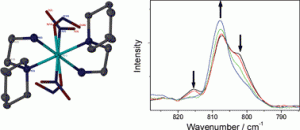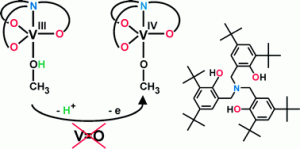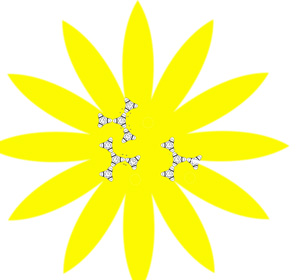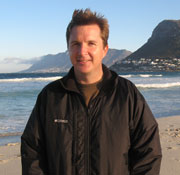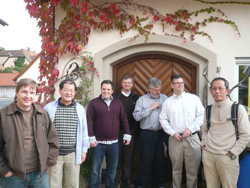
Some of the speakers at Erlangen
Congratulations to Florian Pfaff from the Humboldt-Universität zu Berlin, Germany winner of the Dalton Transactions poster prize at the 3rd Erlangen Symposium earlier this month!
The symposium, organised by Professor Karsten Meyer, covered the topic of Redox-Active Metal Complexes: Control of Reactivity via Molecular Architecture and took place in from October 5th–October 8th, 2011 in Friedrich-Alexander-University Erlangen-Nuremberg in the north of Bavaria.
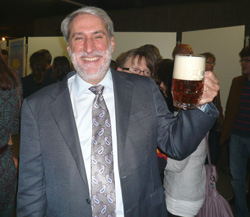
Professor Dan Nocera at a poster session
Redox-active metal complexes are central to many fundamental processes that involve redox transformations of small molecules of industrial and biological relevance, like H2O, N2, NO, H2, O2, CO, and CO2. Research devoted to identifying and mimicking the “structure-function” relationships, which govern the metal complex catalyzed reactions, is essential in order to design novel species capable of catalyzing industrially relevant small molecule transformations.
Speakers included Dan Nocera, Geoff Cloke, Kenneth Karlin, Wonwoo Nam, Paul Chirik, Serena DeBeer, Felix Castellano, Hiroyuki Kawaguchi, Lechoslaw Latos-Grazynski, Frank Neese, Moritz Sokolowski, Felix Tuczek, Michael Wasielewski and Jeremy Smith. This conference aimed to bring together international junior and senior experts to report on and discuss their current research in this field. The conference delegates also had the opportunity to see more of Bavaria on the social activities and of course, to sample the local beer!
More information on the meeting can be found here. And why not also find out more about some of the symposium’s speakers:
The latest ChemComm Highlight from Dan Nocera:
Photocatalytic hydrogen production
Thomas S. Teets and Daniel G. Nocera
Chem. Commun., 2011, 47, 9268-9274 DOI: 10.1039/C1CC12390D
Geoff Cloke’s recent themed issue:
Dalton Transactions Themed Issue on ‘New horizons in organo-f-block chemistry‘ guest edited by Geoff Cloke.
Kenneth Karlin and Wonwoo Nam:
Spectroscopic and computational characterization of CuII–OOR (R = H or cumyl) complexes bearing a Me6-tren ligand
Yu Jin Choi, Kyung-Bin Cho, Minoru Kubo, Takashi Ogura, Kenneth D. Karlin, Jaeheung Cho and Wonwoo Nam
Dalton Trans., 2011, 40, 2234-2241, DOI: 10.1039/C0DT01036G, Paper
This article features in the recent themed issue New Talent: Asia
Find out more about Jeremy Smith in this recent Chemistry World interview
Check out Karsten’s recent Chemical Science Edge Article:
Activation of elemental S, Se and Te with uranium(III): bridging U–E–U (E = S, Se) and diamond-core complexes U–(E)2–U (E = O, S, Se, Te)
Oanh P. Lam, Frank W. Heinemann and Karsten Meyer
Chem. Sci., 2011, 2, 1538-1547 DOI: 10.1039/C1SC00151E
Paul Chirik’s latest Dalton Trans. article:
Cyclisation of α,ω-dienes promoted by bis(indenyl)zirconium sandwich and ansa-titanocene dinitrogen complexes
Doris Pun, Donald J. Knobloch, Emil Lobkovsky and Paul J. Chirik
Dalton Trans., 2011, 40, 7737-7747 DOI: 10.1039/C1DT10149
Were you at the meeting yourself? Or perhaps you also work on redox-active metal complexes? Tell us about your experience by posting a comment on this blog post below…..



